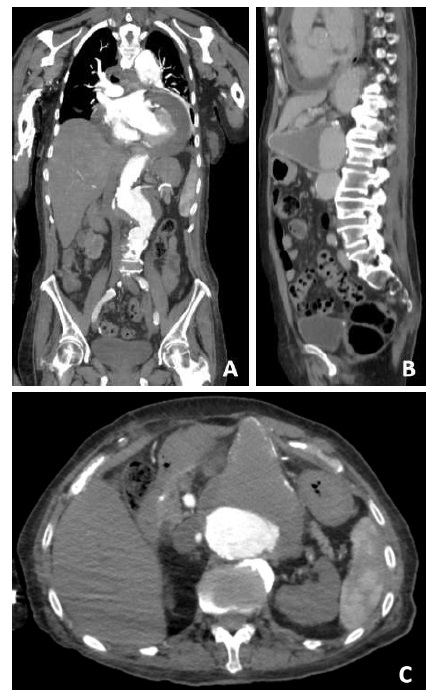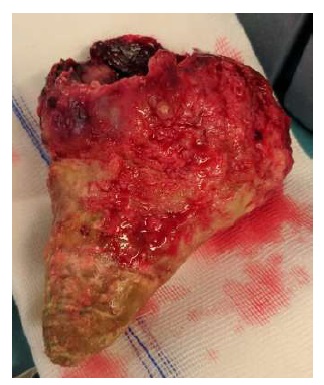Clinical case
80-year-old woman, in need of some assistance in daily activities with a history of arterial hypertension, psoriasis and incipient demential syndrome, was admitted to the emergency department of a peripheral hospital due to severe abdominal pain and shortness of breath. She was hemodynamically stable with a globally painful abdomen and palpable epigastric mass. From the analytical study, she presented with anemia (hemoglobin of 8.3g/dL) and acute kidney injury. Due to the history of Abdominal Aortic Aneurysm (AAA), thoracoabdominopelvic computed tomography (CT) angiography was performed (fig. 1), which revealed a moderate increase in the caliber of the thoracic aorta in its different segments. The ascending aorta was a transversal diameter of 45 mm and the descending aorta of 35 mm. In the abdomen, a large aortic aneurysm was evident, with a conic morphology and a maximum anteroposterior and transverse diameter of 102x89mm. The anterior border of the aneurysm protruded throught the left rectus abdominalis muscle, with a small rupture contained in its posterolateral surface.
She underwent urgent treatment, which, due to the anatomy made endovascular intervention impossible. An open aorto-aortic bypass was performed using an 18mm woven polyester prosthesis (fig 2). The procedure complicated intraoperatively with bilateral iliofemoral occlusion requiring bilateral transfemoral thromboembolectomy. The estimated losses during the procedure were around 1000cc. In total, the patient received 4 red blood cell transfusions. In the postoperative period, the patient developed a refractory shock non-responding to any measures and eventually died 4 hours after the procedure.

Figure 1 Computed angiotomography (CTA) showing a large abdominal aortic aneurysm with a conical shape and contained rupture (A - coronal , B - sagittal and C - axial planes).
Discussion
Abdominal aortic aneurysm is a relatively common pathology and if left untreated, it has a high mortality. It is more frequent in men with a frequency of 4-7% after the age of 50. In women, although rarer (prevalence of 1% after 50 years of age), it presents a higher mortality rate and more often presents with rupture.(1) In case of a rupture, mortality is approximately 81%.(2) Prior diagnosis and treatment when indicated is essential in order to reduce mortality. In older patients, the prognosis is even poorer. Here we present a case of treatment of ruptured abdominal aortic aneurysm of an elderly patient with an uncommon morphology.















